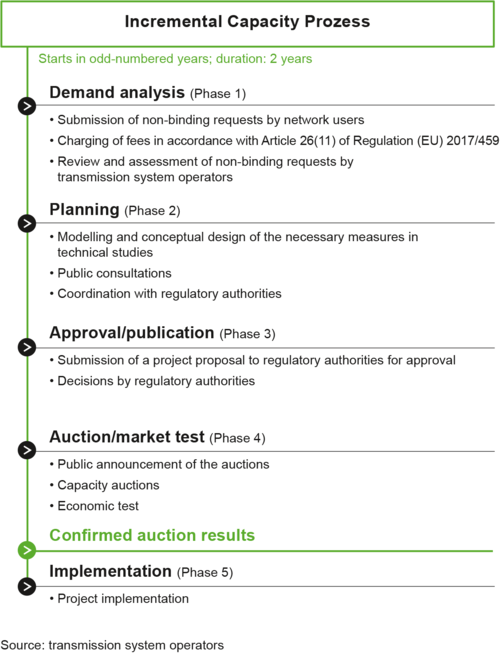Implementation of the incremental capacity process in accordance with Regulation (EU) 2017/459 (Network Code on Capacity Allocation Mechanisms) by the German gas transmission system operators
The German gas transmission system operators bayernets GmbH, Fluxys Deutschland GmbH, Fluxys TENP GmbH, GASCADE Gastransport GmbH, Gastransport Nord GmbH, Gasunie Deutschland Transport Services GmbH, Lubmin-Brandov Gastransport GmbH, NaTran Deutschland GmbH, NEL Gastransport GmbH, Nowega GmbH, ONTRAS Gastransport GmbH, Open Grid Europe GmbH, terranets bw GmbH and Thyssengas GmbH (below referred to as the “TSOs”) provide this website in order to inform market participants on implementation of the incremental capacity process laid down in Regulation (EU) 2017/459 (Network Code on Capacity Allocation Mechanisms) (below referred to as the “CAM NC”).
The incremental capacity process can be roughly divided into five phases (see chart below). In each of these phases both the TSOs as well as the market participants participating in the process have to follow various process steps, all of which may or may not be necessary depending on the circumstances.
The process takes two years and begins every odd-numbered year.
In the first phase, all market participants can register their future capacity requirements without obligation. An inquiry form and the terms and conditions of participation are available for this purpose, which must be sent to the Gas TSOs by post within eight weeks of the annual auction. Fees are charged for each non-binding demand for transportation capacity in accordance with Art. 26 Para. 11 Regulation (EU) 2017/459 (NC CAM). The transmission system operators prepare a demand report based on the valid, non-binding demand indications. If the findings from the demand report lead to a need for incremental capacity, the TSOs prepare a draft project proposal. This contains information on the offer level, technical measures, costs, F-factor and supplementary terms and conditions for the allocation of new technical capacity. All documents are then publicly consulted (phase 2).
In the third phase, the comments are evaluated and project proposals are drawn up. Specifically, the offer levels, information on the economic viability test, supplementary terms and conditions and timetables are recorded and explained. The contents of the project proposals are coordinated with the neighboring transmission system operators. After this coordination, the project proposals are sent to the Federal Network Agency for approval (phase 3).
In the following year, the transmission system operators offer both the new capacities to be created and the available capacities in the annual auction on a primary capacity platform (phase 4). If the auctions and the associated economic test are successful, the capacities are included in the draft of the current scenario framework for the Gas Network Development Plan. The implementation phase for specific projects begins (phase 5).
At the same time, the transmission system operators start a new cycle of the incremental capacity process.
